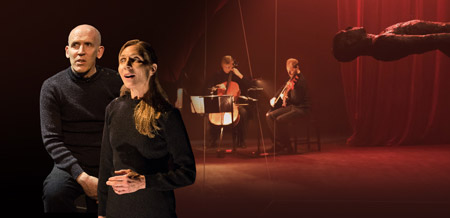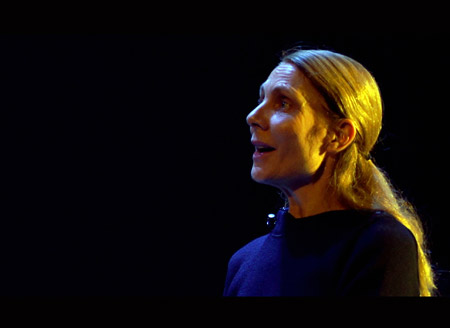Concert, Performance, Play
Conceived and Created by Judy Hegarty Lovett, Paul Clark, Conor Lovett and Caoimhín Ó Raghallaigh
Includes texts from Watt, The Unnameable, Words and Music and Malone Dies
by Samuel Beckett
Director: Judy Hegarty Lovett
Composer/Musical Director: Paul Clark
Additional Composition: Caoimhín Ó Raghallaigh
Hello, Sam Redux, 2016, installation setting by Brian O’Doherty
Gare St. Lazare Ireland
ArtsEmerson
Paramount Main Stage, Washington Street
Theater District, Boston
October 5 – 9, 2016
With Conor Lovett (Actor), Melanie Pappenheim (Singer), Christopher Allan (Cello), Cleek Schrey (Hardanger D’Amore), John-Paul Gandy (Piano)

with musicians and friend
in “Here All Night”
Photo: Courtesy of ArtsEmerson
It begins with drips of piano (John-Paul Gandy) music, a tinkle here, a note there. Gradually, a violinist (Cleek Schrey) – actually a player of the Hardanger D’Amore a violinish-type instrument – emerges and begins to tune, somewhat weirdly. Then a cellist (Christopher Allan) emerges and joins in gradually. Soon the piano part is filling out and a chorus of six and two soloists, Conor Lovett (actor) and Melanie Pappenheim (singer), arrive onstage. What ensues is eighty minutes of riveting music, text and performance, expertly executed.
The text is a grab-bag of Samuel Beckett excerpts, not particularly coherent, nor needing to be so. They work marvelously well, as performed by Conor Lovett, the central wizard of the Gare St. Lazare Players, declaimed as part of a sometimes atmospheric and sometimes punctuated musical background.
The presence of the music and the nature of it help to reinforce the poetic sense of Beckett’s language, always a hair’s breadth away from silence, always teasing emptiness with its dislocations. Beckett always points to the place where language disappears, and here we have the perfect repository for those pointings. As Lovett reads the lines, sometimes filled with considerable humor, and then lets them dissipate and decay, dribble off into incoherences or barely enunciated utterances, the spacious music creates the embrace that holds them.

in “Here All Night”
Photo: Courtesy of ArtsEmerson
Melanie Pappenheim’s soprano is exquisitely clear and evokes a sense of pastoral purity in the midst of absence and darkness. Supported by the incredibly well disciplined and evocative six woman chorus, her voice calls out over the brambles of words and gestures of the piano trio to create a clarion of peace and reserve.
The music is so tight and well done and so well integrated with the action of the piece that one is almost stunned that this is billed more as a theatrical than as a musical endeavor. Its execution is top notch. Paul Clark’s music is quite complex, but artful and appropriately tuned tonally to the Beckettian requirements. It eases in from a point in distant space and leaves the same way. But in the middle of its declared presence, it gesticulates, waves, bobbles, bounces, and is fully of interest and verve.
The set, an installation, in fact, by Brian O’Doherty, consists of a suspended body surrounded by an array of wires that reach up in various directions to the high reaches of the space of the theater. It’s simple, straightforward, but very effective in creating an abstract geometry that holds the players but also evokes a kind of existential urgency.
Oddly, after seeing and hearing this quite abstract piece, I wanted to see and hear it again. There was something penetrating and profound about the combination of spacious, but varied, musicality, and the fragmentary but suggestively poetic quotations from Beckett. It felt more like a prayer than a performance, something that one almost wants to turn into a ritual, to repeat it and keep it close to home.
They’re only here for a few days, so catch it if you can.
– BADMan
Leave a Reply